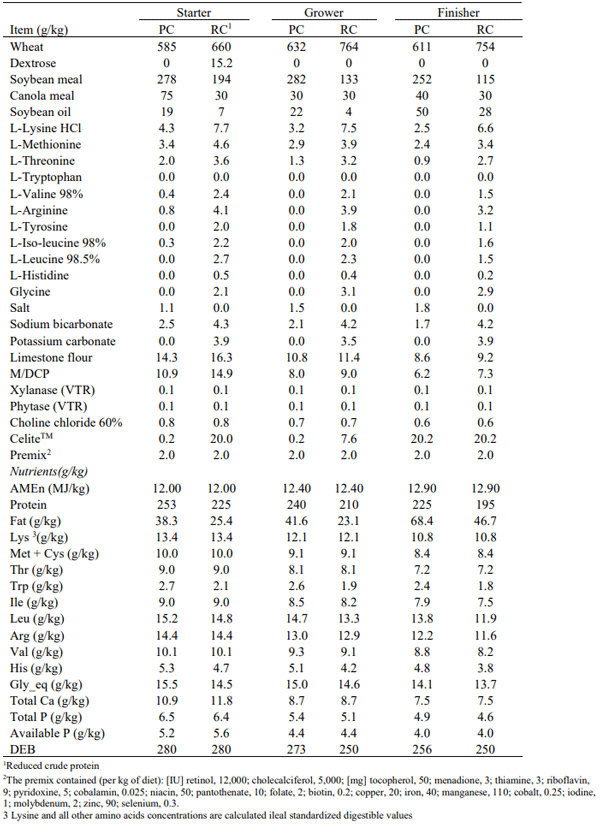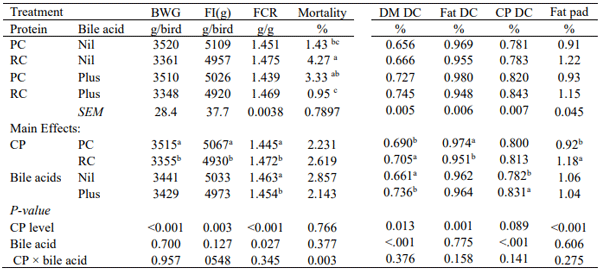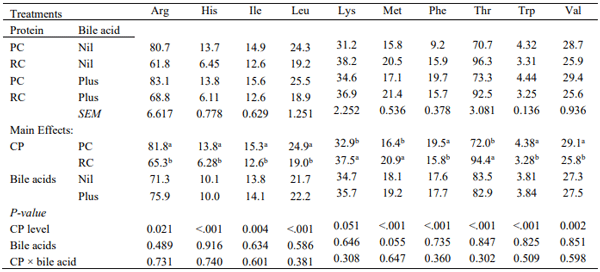I Introduction
In recent years, based on ideal amino acids profile, a moderate reduction in dietary CP, 20 to 30 g/kg, has been reported to maintain broiler chicken performance and processing yields. However, further reduction of CP more than 30 g/kg has been shown to compromise bird performance and increase adipose fat accumulation (Kidd et al, 2021). These reduced CP levels are usually achieved by increasing feed grains such as wheat inclusion at the expense of soybean meal, relatively increasing carbohydrates or starch levels as the energy source.
Bile acids are synthesized from cholesterol in the liver (Chiang 2002) and secreted into the duodenum to facilitate intestinal digestion and absorption of dietary fat (Hofmann et al., 2008). Bile acids could be metabolised further by bacteria in the intestine. Bacterial enzymes act on the primary bile acids and convert them to secondary bile acids by deconjugation, dehydroxylation, epimerization, and oxidation. The enterohepatic circulation of bile acids is the recycling of bile acids between small intestine and liver; although this process is efficient, some salts and acids are nonetheless lost with every cycle of the enterohepatic circulation (Lai et al., 2018). Furthermore, increased ingestion of non-starch polysaccharides (NSP) present in grains, particularly wheat, has been reported to sequester bile acids, thus enhancing faecal bile acid loss in human (Walters et al., 1975), rats (Overton et al., 1994) and poultry (Choct, 1999). Therefore, the current study was designed to investigate if bile acids supplementation in reduced CP diets with increased NSP content mitigates the possible performance loss previously observed with feeding diets with lower crude protein concentration.
Table 1 - Ingredient compositions and calculated nutrient specifications of experimental diets
II Materials and methods
The feeding study was performed according to the specific guidelines approved by the Animal Ethics Committee of The University of Sydney. A total of 840 off-sex male Ross 308 chicks (parent line) were reared to 42 days post-hatch on three phases of feeding (starter crumble, 0 to 14 d; grower pellet, 15 to 28 d, and finisher pellet from 29 to 42 d). The experimental design was a 2 × 2 factorial array of treatments to evaluate the effect of two dietary levels of crude protein and two levels of bile acid supplementation (0 and 0.2 g/kg feed) for a total of four dietary treatments. There were six replicate pens of 35 birds per treatment. The standard positive control (PC) diet was formulated to meet or exceed the 2019 Aviagen Ross 308 nutrition specifications and reduced CP diet was formulated with around 30 g/kg CP reduction as shown in Table 1. All diets contained phytase and xylanase to be commercially relevant. Chickens had ad libitum access to feed and water. Initial and final body weights were determined, and feed intakes were recorded from which feed conversion ratios (FCR) were calculated. On day 42, 6 birds selected at random from each pen were sacrificed to collect distal ileal digesta and fat pad data. On day 34, blood samples were collected from 3 birds per pen from the wing vein into heparinised vials to prevent blood clotting. Plasma samples were separated and the concentrations of essential amino acids in plasma were determined using precolumn derivatisation amino acid analysis with 6-aminoquinolyl-N-hydroxysuccinimidyl carbamate followed by separation of the derivatives and quantification by reversed phase ultraperformance liquid chromatograph. All data were checked for normal distribution and then analysed by two-way ANOVA using JMP Pro 15 (SAS Institute, Carey, North Carolina, USA). Statistical significance was considered at P ≤ 0.05.
Table 2 - The influence of dietary treatments on growth performance (0-42 days) and ileal fat, CP and DM digestibility coefficient (DC)
III Results and discussion
The effects of dietary treatments on growth performance and plasma essential amino acids concentrations are shown in Tables 2 and 3, respectively. Reducing 30 g/kg CP significantly depressed BWG and FI by 4.8 % and 2.8%, respectively (P < 0.01). The grain source used in this study was wheat and, according to the data published by Chrystal et al. (2021), maize-based diets hold an advantage over wheat-based diets following reductions in dietary CP levels. So, the lower BWG and higher FCR with reduced-CP diets could to some extent be because of the background grain (wheat) used in this study. Reducing dietary CP significantly decreased plasma Val, Ile, Leu, Arg, Phe, and Trp concentration but increased Lys, Met and Thr (P < 0.01). Such differences in plasma amino acids concentration indicate that in the current reduced CP diets, Lys, Met and Thr were not absorbed and deposited to a similar extent as other amino acids, implying an imbalance of amino acids profile at the site of protein synthesis. This should have limited bird performance, although reduced CP diets were also formulated to similar ideal amino acids ratio as PC diets, suggesting that the ideal amino acid ratio or the digestion and absorption rate of amino acids in reduced CP diets should be different to that of a normal CP diet. Interestingly, adding bile acids to reduced CP diets significantly reduced mortality rate (P < 0.01). In low CP diets the liver is under high metabolic pressure for protein synthesis and de-amination, plus the higher NSP content in such diets can increase bile acid faecal loss, imposing more burden on liver to increase bile acids production. Thus, supplementation of exogenous bile acids might have alleviated the metabolic pressure on the liver and increased bird liveability. Bile acids addition had no effect on ileal fat digestibility but significantly improved ileal dry matter and protein digestibility, confirming that bile acids can enhance protein digestibility by accelerating hydrolysis process during digestion (Gass et al., 2007).
Table 3 - The influence of dietary treatments on plasma essential amino acid profile (µg/mL)
ACKNOWLEDGEMENT: The authors would like to thank Shandong Longchang for funding this research project
Presented at the 33th Annual Australian Poultry Science Symposium 2022. For information on the next edition, click here. 















.jpg&w=3840&q=75)